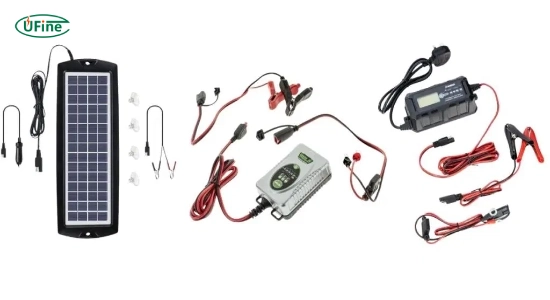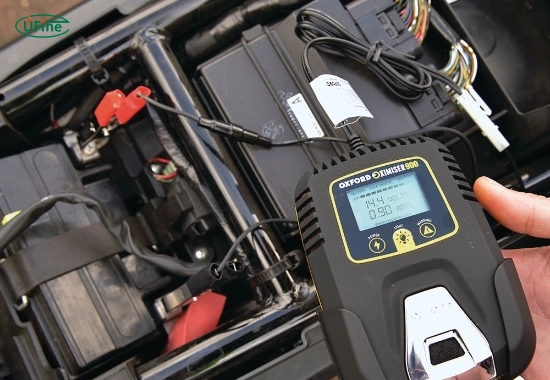Using the best motorcycle battery tender is essential if your bike runs on a lithium battery. These high-performance batteries require special charging care; a regular charger won’t cut it. Whether you’re storing your bike over the winter or want it ready for the next ride, investing in the right battery tender ensures your lithium battery stays healthy and lasts longer.
If you’re wondering whether battery tenders are worth it, especially for lithium batteries, this guide is for you. Let’s dig into how they work, why lithium batteries need special attention, and which tenders are worth your money.
Part 1. What is a motorcycle battery tender and how does it work?
A battery tender (also known as a smart charger or trickle charger) is a device that keeps your motorcycle battery charged when you’re not using the bike. Unlike traditional battery chargers, which deliver a constant stream of power, a battery tender is smart. It monitors your battery’s condition and automatically adjusts the charge rate.
How does it work?
The tender works in phases:
- Bulk charging: brings the battery up to 80% quickly.
- Absorption phase: slows down to bring it to full charge.
- Float mode: maintains a full charge without overcharging.
This process ensures your lithium motorcycle battery is always ready to go without suffering from overcharging or deep discharging.
Part 2. Why lithium motorcycle batteries need special care?
Lithium motorcycle batteries, especially LiFePO4 (Lithium Iron Phosphate) types, are known for their lightweight, fast charging, and long lifespan. But they’re also more sensitive to voltage and temperature than traditional lead-acid batteries.
Key differences:
- Voltage sensitivity: Overcharging or undercharging can permanently damage lithium batteries.
- No sulfation: Unlike lead-acid batteries, lithium doesn’t suffer from sulfation but can still degrade if not stored properly.
- Built-in BMS: Many lithium batteries have a Battery Management System that requires compatible chargers.
Because of these traits, a standard lead-acid charger can damage or even destroy a lithium battery. That’s why using the best motorcycle battery tender for lithium is crucial.
Part 3. What happens if you don’t use a lithium-compatible battery tender?
If you store your bike for weeks or months without using a lithium-compatible battery tender, you risk:
- Battery drain: Lithium batteries have low self-discharge, but accessories like alarms or ECUs can still drain them over time.
- Deep discharge damage: Letting a lithium battery fall below a certain voltage can render it unchargeable.
- Shortened lifespan: A battery that should last 5–8 years might die in 2–3 years without proper maintenance.
- Starting problems: Cold weather or infrequent use can lead to a weak or no start.
A proper battery tender avoids all these problems by maintaining safe voltage levels automatically.
Part 4. Key features of the best motorcycle battery tenders
When you’re shopping for a battery tender for your lithium battery, look for these features:
✅ Lithium mode
This is non-negotiable. The charger must be compatible with lithium-ion or LiFePO4 batteries.
✅ Automatic shut-off and float charging
Smart tenders stop charging when the battery is full and switch to a low-voltage maintenance mode.
✅ Low-voltage recovery
Some lithium batteries go into “sleep mode” if drained too far. The best tenders can safely bring them back.
✅ Temperature protection
Lithium batteries don’t charge well in extreme cold. A good tender adjusts or pauses charging based on temperature.
✅ Reverse polarity and spark protection
Prevent short circuits or damage from incorrect connections.
✅ Compact and portable design
Look for a unit that’s easy to store and use, especially in tight garage spaces.
Part 5. Who needs a lithium battery tender the most?
Not every rider needs a battery tender year-round, but here’s who definitely should use one:
- Seasonal riders: If you store your bike during winter, you need a battery tender to prevent deep discharge.
- Urban commuters: Short rides don’t always give the battery time to recharge fully.
- Adventure and off-road riders: Long trips between rides can drain the battery.
- Motorcycle collectors: Multiple bikes sitting idle need constant maintenance.
Even if you ride regularly, a tender helps ensure your lithium battery stays fully charged and healthy.
Part 6. Best motorcycle battery tenders for lithium in 2025
Here are five top-rated battery tenders designed explicitly for lithium motorcycle batteries. Each has been selected based on performance, safety, and user reviews.
- Battery Tender® Junior 800 for Lithium (LiFePO4)
- Voltage: 12V
- Amps: 800mA
- Why it’s great: Compact, affordable, and made specifically for lithium. It has a dedicated lithium mode and auto shut-off.
- Best for: Daily riders and long-term storage.
- NOCO GENIUS1 Smart Charger
- Voltage: 6V/12V
- Amps: 1A
- Why it’s great: Ultra-versatile, charges multiple battery types including lithium. Built-in diagnostics and repair mode.
- Best for: Riders with multiple battery types.
- OptiMate Lithium 4s 0.8A Charger
- Voltage: 12.8V–13.2V
- Amps: 0.8A
- Why it’s great: Tailor-made for lithium batteries, this charger can recover deeply discharged batteries and maintain them for months.
- Best for: Winter storage and long-term maintenance.
- CTEK Lithium US Charger
- Voltage: 12V
- Amps: 4.3A
- Why it’s great: Fast charging with pulse maintenance. Optimized for LiFePO4. Premium build and easy to use.
- Best for: Riders who want fast, safe charging with high-end features.
- Foval Automatic Lithium Battery Charger
- Voltage: 12V
- Amps: 1A
- Why it’s great: Budget-friendly, reliable, and fully automatic. Safe for lithium and perfect for beginners.
- Best for: DIYers and casual riders.
Part 7. How to use a lithium battery tender safely?
Using a lithium battery tender is straightforward, but a few tips will ensure safety and effectiveness:
- Read the manual: Each charger has slightly different instructions.
- Connect properly: Red to positive, black to negative. Always connect before plugging into the wall.
- Ensure lithium compatibility: Double-check that the tender is set to lithium mode.
- Store in a dry place: Avoid rain, snow, or extreme heat.
- Check battery condition: If the battery is below 10V, some tenders may not detect it. You might need a tender with recovery mode.
Part 8. Common mistakes to avoid with battery tenders
Here are some frequent errors that can cost you time, money, and battery life:
- Using a lead-acid charger on a lithium battery
- Leaving the battery completely disconnected for months
- Not checking the voltage before and after charging
- Using a tender without temperature adjustment in the cold
- Overlooking reverse polarity warnings
Avoiding these mistakes ensures your lithium battery stays in top shape.
Part 9. How to know if your battery needs a tender?
Here are signs your lithium motorcycle battery might need regular tender use:
- The bike struggles to start after sitting
- Lights dim while idling
- Battery voltage drops below 12.8V
- You’ve jump-started your bike recently
- The bike has been stored for more than 2 weeks
A tender prevents these issues by keeping your battery at the ideal voltage.
Part 10. How to choose the best motorcycle battery tender for your needs?
Here’s a quick guide to help you make the right choice:
| Feature | Why It Matters |
|---|---|
| Lithium Mode | Prevents overcharging or damage |
| Amperage | 0.75A–1.5A is ideal for motorcycles |
| Maintenance Mode | Keeps battery topped off safely |
| Recovery Feature | Revives deeply discharged batteries |
| Brand Quality | Trusted brands offer better safety and support |
| Ease of Use | Consider display, cables, and installation |
| Weatherproofing | Important for outdoor or garage use |
Part 11. FAQs
Can I use a regular battery charger on a lithium motorcycle battery?
No. Regular chargers may overcharge or damage lithium batteries. Always use a lithium-compatible tender.
How long should I leave the tender connected?
You can leave a smart lithium tender connected indefinitely. It automatically adjusts and maintains safe voltage levels.
Can a battery tender revive a dead lithium battery?
Some advanced tenders have a recovery mode for batteries that have dropped below 10V, but not all can. Check the specs.
Is it necessary to disconnect the battery before using a tender?
No, most lithium battery tenders are safe to use with the battery connected to the bike.
What’s the best amperage for a motorcycle battery tender?
For lithium motorcycle batteries, 0.75A to 1.25A is ideal. Higher amps can charge faster but may not be necessary for maintenance.
Related Tags:
More Articles

The Ultimate Guide to Choosing the Right Ice Fishing Battery for Your Setup
Find the best ice fishing battery for your gear with this guide. Learn types, sizes, and tips to keep your setup running strong all winter.
Why Lithium Is the Best Battery for Ice Fishing: 7 Scientific Reasons
Lithium batteries excel in ice fishing with superior cold performance, longer life, and lighter weight with seven science-backed reasons explained.
How to Choose the Best Lithium Watch Battery for Your Timepiece?
Learn how to choose the best lithium watch battery to boost performance, ensure safety, and extend the life of your analog or digital timepiece.
Step-by-Step: Integrating a Micro LiPo Battery into Your DIY IoT Project
Power your smart IoT device with a micro LiPo battery. Learn how to connect, charge, and use it safely in this hands-on DIY guide.
Best Use Cases for 12V High Ah Lithium Batteries: From RVs to Telecom Backup
Discover the best uses for 12V high Ah lithium batteries—perfect for RVs, solar, marine, and telecom backup power in 2025 and beyond.





